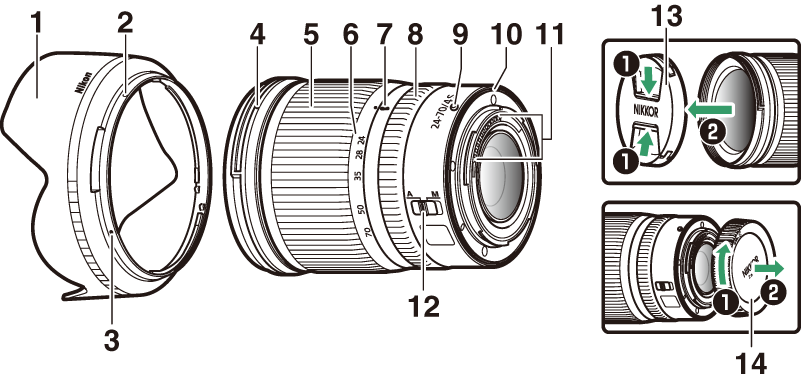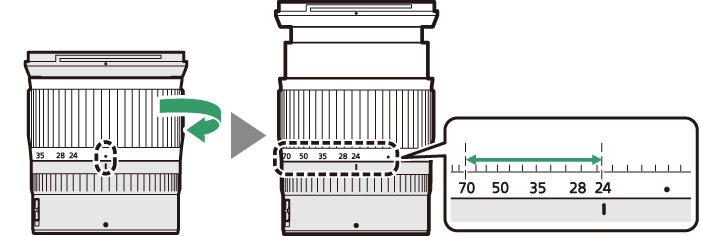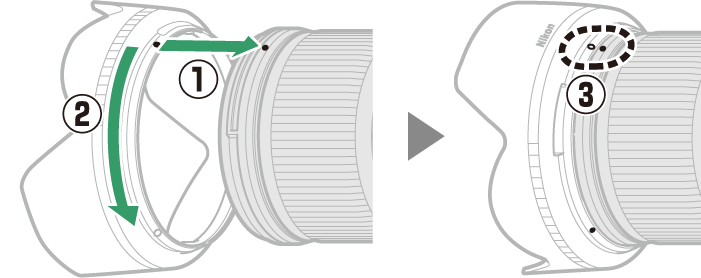NIKKOR Z 24–70mm f/4 S Lens Manual
This section is included as a lens manual for purchasers of the NIKKOR Z 24–70mm f/4 S lens kit.
Note that lens kits may not be available in some countries or regions.
Using the Lens
Parts of the Lens: Names and Functions
The parts of the NIKKOR Z 24–70mm f/4 S are listed below.

|
1 |
Lens hood |
Lens hoods block stray light that would otherwise cause flare or ghosting. They also serve to protect the lens. |
|
2 |
Lens hood lock mark |
Use when attaching the lens hood. |
|
3 |
Lens hood alignment mark |
|
|
4 |
Lens hood mounting mark |
|
|
5 |
Zoom ring |
Rotate to zoom in or out. Be sure to extend the lens before use. |
|
6 |
Focal length scale |
Determine the approximate focal length when zooming the lens in or out. |
|
7 |
Focal length mark |
|
|
8 |
Control ring |
|
|
9 |
Lens mounting mark |
Use when mounting the lens on the camera. |
|
10 |
Rubber lens-mount gasket |
— |
|
11 |
CPU contacts |
Used to transfer data to and from the camera. |
|
12 |
Focus-mode switch |
Choose for autofocus, for manual focus. Note that regardless of the setting chosen, focus must be adjusted manually when manual focus mode is selected using camera controls. |
|
13 |
Front lens cap |
— |
|
14 |
Rear lens cap |
— |
Attachment and Removal
Attaching the Lens
-
Turn the camera off, remove the body cap, and detach the rear lens cap.
-
Position the lens on the camera body, keeping the mounting mark on the lens aligned with the mounting mark on the camera body, and then rotate the lens counterclockwise until it clicks into place.
Removing the Lens
-
Turn the camera off.
-
Press and hold the lens release button while turning the lens clockwise.
Before Use
The lens is retractable and must be extended before use. Rotate the zoom ring as shown until the lens clicks into the extended position. Pictures can only be taken when the focal length mark points to positions between 24 and 70 on the focal length scale.

-
To retract the lens, rotate the zoom ring in the opposite direction, stopping when you reach the (I) position on the focal length scale.
-
If the camera is turned on with the lens retracted, a warning will be displayed. Extend the lens before use.
Attaching and Removing the Lens Hood
Align the lens hood mounting mark (I) with the lens hood alignment mark (I) and then rotate the hood (w) until the I mark is aligned with the lens hood lock mark (K).
To remove the hood, reverse the above steps.

When attaching or removing the hood, hold it near the I symbol on its base and avoid gripping it too tightly. The hood can be reversed and mounted on the lens when not in use.
When the Lens Is Attached
The focus position may change if you turn the camera off and then on again after focusing. Refocus before shooting. If you have focused on a pre-selected location while waiting for your subject to appear, we recommend that you do not turn the camera off until the picture is taken.
Precautions for Use
-
Do not pick up or hold the lens or camera using only the lens hood.
-
Keep the CPU contacts clean.
-
Should the rubber lens-mount gasket be damaged, cease use immediately and take the lens to a Nikon-authorized service center for repair.
-
Replace the lens caps when the lens is not in use.
-
To protect the interior of the lens, store it out of direct sunlight.
-
Keep the lens dry. Rusting of the internal mechanism can cause irreparable damage.
-
Leaving the lens in extremely hot locations could damage or warp parts made from reinforced plastic.
-
Rapid changes in temperature may cause damaging condensation inside and outside the lens. Before taking the lens from a warm to a cold environment or vice versa, place it in its case or a plastic bag to slow the change in temperature.
-
We recommend that you place the lens in its case to protect it from scratches during transport.
Lens Care
-
Removing dust is normally sufficient to clean the glass surfaces of the lens.
-
Smudges and fingerprints can be removed from fluorine-coated lens elements using a soft, clean cotton cloth or lens cleaning tissue; clean from the center outwards using a circular motion. To remove stubborn stains, wipe gently using a soft cloth lightly dampened with a small amount of distilled water, ethanol, or lens cleaner. Any drop-shaped marks left from this process on the water- and oil-repellent surface can subsequently be removed with a dry cloth.
-
When cleaning lens elements that are not fluorine-coated, remove smudges and fingerprints using a soft, clean cotton cloth or lens cleaning tissue lightly dampened with a small amount of ethanol or lens cleaner. Wipe gently from the center outwards in a circular motion, taking care not to leave smears or touch the lens with your fingers.
-
Never use organic solvents such as paint thinner or benzene to clean the lens.
-
Neutral Color (NC) filters (available separately) and the like can be used to protect the front lens element.
-
If the lens will not be used for an extended period, store it in a cool, dry location to prevent mold and rust. Do not store in direct sunlight or with naphtha or camphor moth balls.
Accessories
Supplied Accessories
-
LC-72B 72 mm snap-on Front Lens Cap
-
LF-N1 Rear Lens Cap
-
HB-85 Bayonet Hood
-
CL-C1 Lens Case
-
The case is intended to protect the lens from scratches, not from falls or other physical shocks.
-
The case is not water resistant.
-
The material used in the case may fade, bleed, shrink, or change color when rubbed or wet.
-
Remove dust with a soft brush.
-
Water and stains can be removed from the surface with a soft, dry cloth. Do not use alcohol, benzene, thinner, or other volatile chemicals.
-
Do not store in locations exposed to direct sunlight or high temperatures or humidity.
-
Do not use the case to clean the monitor or lens elements.
-
Be careful that the lens does not fall from the case during transport.
Material: Polyester
Compatible Accessories
72 mm screw-on filters
Use only one filter at a time. Remove the lens hood before attaching filters or rotating circular polarizing filters.
Specifications
|
Mount |
Nikon Z mount |
|
Focal length |
24 – 70 mm |
|
Maximum aperture |
f/4 |
|
Lens construction |
14 elements in 11 groups (including 1 ED lens element, 1 aspherical ED element, 3 aspherical elements, elements with Nano Crystal Coat, and a fluorine-coated front lens element) |
|
Angle of view |
|
|
Focal length scale |
Graduated in millimeters (24, 28, 35, 50, 70) |
|
Focusing system |
Internal focusing system |
|
Minimum focus distance |
0.3 m (0.99 ft) from focal plane at all zoom positions |
|
Diaphragm blades |
7 (rounded diaphragm opening) |
|
Aperture range |
f/4 – 22 |
|
Filter-attachment size |
72 mm (P = 0.75 mm) |
|
Dimensions |
Approx. 77.5 mm maximum diameter × 88.5 mm (distance from camera lens mount flange when lens is retracted) |
|
Weight |
Approx. 500 g (1 lb 1.7 oz) |
-
Nikon reserves the right to change the appearance, specifications, and performance of this product at any time and without prior notice.
